A flock of Red-winged Blackbirds arrived at the feeder. A grackle perched in a spectacular fashion in the sumac outside the office window at work. In the hour before dawn, the first woodcocks of the year were ‘peenting’ and whistling in the field above the pond. Hen turkeys have returned to wander under the birdfeeders in hopes of an easy meal. Bluebirds are singing, singing, singing.
I write this the Monday after Daylight Savings Time and it all has me thinking about schedules and time and rhythm and cycles. In my nature journal, the blackbirds and woodcocks appeared the same date as last year, March 5 and 11 respectively. The Song Sparrow was a day late, and the Turkey Vulture was a few days early. Regardless of the day-to-day changes, something larger governs their movements.
The plants follow the same patterns. Right on time, the crocus leaves emerge from the hillside. This year they are joined by 200 or so more spring bulbs I planted last fall. The early daffodils are sprouting, as are some of the hyacinths. The trails at Audubon have that distinctive scent of skunk cabbage as the freeze-thaw cycle means nothing to these incredible heat-generating flowers.

The pussy willows are just starting to gleam silver as their fuzzy flower buds break through their winter dormancy, and in a view across the valley, the tips of the trees are blushing yellow, orange, red, and green as the later winter sun hearkens them to awaken.
The sap is flowing well in the Sugar Maples, and it brings me back to the topic of time and cycles. For this season, however long it might be, the cycles on the farm are linked far more to nature’s calendar than the human one. We boil sap when the days are such that the trees run enough for our buckets to fill. Cold mornings slow it down, regardless of what the predicted high is for the day. And so some days we boil at 11:00 a.m., others not until 4:00 p.m.
Perhaps this is why changing the time seems like such a strange act. This is a season so embedded in its cycles. I find myself just starting to feel in sync with the world as I wake when the birds do. And then we decide to jump an hour ahead… so now not only is my schedule off kilter, but I have to modify the schedules of the chickens, cats, and backyard birds (with whom I’ve established a very set routine over the winter for feeding time). I imagine for farmers with livestock, it is much more of a hassle – to try and maintain ‘farm’ time while also having to follow ‘human’ time. And for what?
I was thinking about it the other day and, while there are many complications, I wondered what it would be like if we operated in daylight schedules – dawn, early morning, morning, late morning, early afternoon, afternoon, late afternoon, early evening, evening, dusk, night. Less efficient in the human world, certainly. Harder to set ‘open hours’ for business or make lunch dates with friends. But I think we would adapt quickly. And maybe relax a lot more because we wouldn’t have a clock telling us where to be when.

I think there is a part within each human that longs for that schedule, to be part of the greater world in our daily routines. I wonder if we would get as accurate at the woodcocks, the bluebirds, and the turkeys at knowing when to move, eat, court, and nest. And as we move through the end of a pandemic, in which we’ve all adjusted and adapted, I think we all know so much better what we are capable of. Of course we can do this better, this thing called living. Eat when we’re hungry, sleep when we’re tired, visit when we’re lonely, sing when we’re happy; hibernate when its cold or layer up and play in the snow, hunker down on rainy spring nights or wander into the mist in search of vernal pools.
If I could step away from the world of clocks and watches and phones that tell us when and where to be, I would. I try to do just that when I can – weekends and evenings, and mornings (until today when the time change took those away for another month). I’ll note the return of the kestrel to the nesting box, the Savannah Sparrows, and the Blue-winged Warblers to the farm, when the maples claim their sap for themselves and sugar season is done, when the apple trees start to blossom, and the rest of the bulbs break through the winter ground.
Take a walk somewhere, every week. It doesn’t have to be in the wilderness, your neighborhood street will do. Watch how the plants and animals grow into spring, change their cycles to match the season, and thrive on a schedule that matches a greater movement.
Sarah Hatfield is Education Coordinator at ACNC.
Audubon Community Nature Center builds and nurtures connections between people and nature. ACNC is located just east of Route 62 between Warren and Jamestown. The trails are still open from dawn to dusk but Liberty, the Bald Eagle is currently off display during the construction of the Pamela A. Westrom Wildlife Habitat. You can visit her on her Facebook page. The Nature Center is partially open, including restrooms, the Blue Heron Gift Shop, and some exhibits. More information can be found online at auduboncnc.org or by calling (716) 569-2345.


Recent Comments